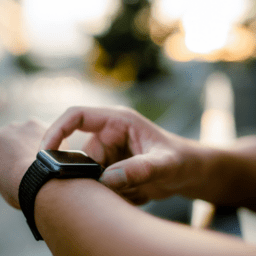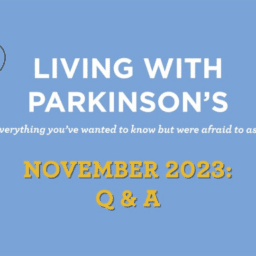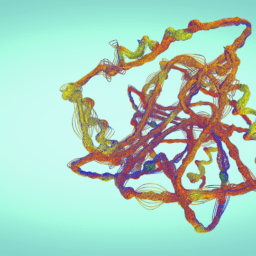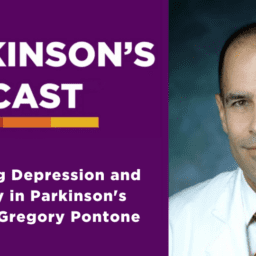In this conversation, occupational therapist Carol Chiang explains how occupational therapy and AgeTech can help people with Parkinson’s complete activities of daily living, and how home adaptations can help you live well with Parkinson’s today and into the future.
The notes below highlight and expand upon some of the core messages from the webinar discussion. Watch or listen to the complete recording using the links that follow this paragraph. You can also subscribe to our YouTube page and be alerted as soon as a new video is uploaded.
An audio version of this webinar is available.
SHOW NOTES
Occupational Therapists: “Professional Problem Solvers”
Carol explained that occupational therapy (OT) exists to help people with the “jobs of living.” Although these “jobs” (or occupations) are often taken for granted–processes like tying shoes, putting away dishes, or taking a shower–performing activities of daily living (ADLs) is essential to living well. When performing these activities becomes difficult, occupational therapy can help.
Occupational therapy takes a holistic view and looks at the whole picture of the job of living. It centers on making adjustments and adaptations to help you live your best life based on your current abilities.
Safe Home Environments
Person. Environment. Occupation.
The interaction between these three points of an OT triangle determine how successfully an activity of daily living will be done. This means every individual has unique habits that should be taken into account when creating or modifying a home environment, and that environment should be uniquely arranged for that person’s needs. The occupation, as mentioned earlier, is the task that needs to be done.
The takeaway of this triangle is that you can make adjustments to a person’s specific needs by changing their environment, which makes it easier for them to complete their jobs of living. It means matching the person to their environment so that they are harmonized, Carol explains. Think of it this way: When you are raising children or pets, you often modify your home to keep your little ones safe. It works the same way as you get older; you may need to modify your space to stay safe and independent for as long as possible.
At-home Adaptations
There are numerous adjustments you can make at home to create a safe space, one where you or your person with Parkinson’s can successfully accomplish not only their daily tasks but also the activities they love. Consider updating lighting fixtures. This can be as simple and economical as buying small touch lamps or as involved as installing motion or voice-activated lighting systems.
Another important aspect of home life to consider is a person’s “path of travel”: the route(s) they typically take throughout their home. On a walk from your kitchen to your living room, for example, what might you encounter that could present challenges? A rug? A long hallway or narrow doorway where freezing may occur? A staircase?
Next, think about adjustments you could make to minimize your hazards along that path. Could you move (or remove) a rug? Add a banister or grab bar to the wall? Could you add visual cues to your stairs, such as runners that have a strong color contrast with the stairs to make them stand out? There are so many small but impactful ways you can adjust your current living space to make it safer.
Declutter, declutter, declutter
While there are countless devices to help people with Parkinson’s maintain their independence at home–like motion-activated lights and automatic doors–many of these can be expensive and out of reach. What is not inexpensive, however, and what can be a powerful first step to creating a safe home environment, is simply to declutter.
Open floor plans work well for people with Parkinson’s, Carol explained, partly because they eliminate clutter. Clutter creates anxiety and increases the risk of freezing and falls. By creating open spaces and moving things out of the way, you reduce your risks and can more easily navigate your daily life.
AgeTech
Carol said the key to living well with Parkinson’s is to do as much as you can for as long as you can. When the time comes that you need an extra boost, explore the ways technology can help.
AgeTech, or technology specific to aging adults, helps older folks remain independent at home and manage problems we experience as we age. It includes everything from fall detection services and smartwatches to companionship tools and speech and music therapy devices/apps.
Carol highlighted that there is an ongoing transition in the tech world to devices and tools personalized to the user. There are solutions for many struggles that people may be experiencing, she said, and new solutions are being developed every day.
How can technology help bridge a gap in your life?
Fall Detection, Recovery, and Prevention Devices
There are many options available for fall detection devices, from pendants to smartwatches to whole systems with sensors in different rooms or zones of your home. All have pros and cons, and costs widely vary depending on the system and its capabilities.
Numerous devices have been developed for fall prevention, as well. Lasers and auditory or visual cues help by showing or telling you where or when to step; they can also help you increase your step length. One such device is NexStride: an assistive device that attaches to a cane, walker, or walking poles and provides on-demand visual and auditory cues (which can be customized) in the form of a green laser line and metronome.
Similarly, there are both walkers and much smaller devices you can attach to your shoes that can monitor step length and help you and your care team see if your stride is changing. These tools are “predictive AI,” Carol explained, because they can predict your risks by measuring current happenings. If a device shows that your gait length is getting shorter, for example, this indicates that your risks of falls has increased. Use this data to be proactive and take action to minimize falls.
Tremors and Medication Management Devices
NeuroRPM is FDA-approved software on an Apple Watch that passively monitors various Parkinson’s symptoms. It stores this information in one place, so you and your care team can see how your medications actually impact your symptoms. Using the data collected from the watch, your physician can tweak your medication regimen in vastly helpful ways. Because the app involves passive monitoring, it gathers data for you without your having to do anything. This passive monitoring, Carol said, is key.
Another FDA-approved app, StrivePD, is designed for people with Parkinson’s and automatically records data to an Apple Watch about tremors, dyskinesia, sleep patterns, mobility, gait, falls, and more. It can also record data you self-report about medication timings, symptoms, and other aspects of Parkinson’s; track certain DBS settings to understand the effect the settings have on your symptoms; and maintain a record of your clinical history–including changes to your medication regimen.
Devices to help with ADLs
Many clothing and footwear companies sell adaptive apparel to help people with Parkinson’s get dressed more easily. Some rely on magnetic buttons or zippers, while others you can step into with ease, such as shoes that are easy to slip on and off.
There are also new walkers that slide all the way down to the floor, which helps you stand up after a task like cleaning out a bottom kitchen drawer. These walkers also provide peace of mind about how you will stand back up if you were to fall.
Cooking and Cleaning Devices
Carol and Polly both remarked that cleaning can be good exercise, so finding tools that eliminate cleaning from your life is not the goal here. However, there are numerous devices that can help make it easier, from robot vacuums to a “smart knob” that can be installed on your stove and turned off via cell phone.
Speech and Voice Devices
Speech and voice impairments are common among people living with Parkinson’s, and speech can become softer and less intelligible as Parkinson’s progresses. This not only impacts quality of life but can be a concern for people with Parkinson’s at risk of falls and other injuries since they may not be able to speak loudly on a phone or other device to call for help. Fortunately, there are many speech and voice apps and tools that make it easier to be heard and understood. Whissp is a tool that amplifies your voice and relies on pre-recorded messages to help keep you safe.
CONCLUSIONS
Making adjustments can be hard, Carol reminded listeners. The key is to think about the activities that bring you joy, and any challenges that make those activities more difficult. Take action to address those challenges, whether through small adaptations or broader changes. Remember that every day, new and extraordinary tools are being developed to help you live well with Parkinson’s. Find what works for you and set yourself up for success, today and for years to come.
ADDITIONAL RESOURCES
[Webinar Recording] Aging in Place with Parkinson’s
The Parkinson’s Home Safety Checklist
Americans with Disabilities Act (ADA) and renters
Bemis Assurance 3″ Raised Toilet Seat with Handles and Bidet Attachment
Floor-to-ceiling tension grab bar
Whole-home sensors for fall prevention
8 Best Fall Detection Devices of 2024: Our Experts Tested and Reviewed
Speaker Bio


















